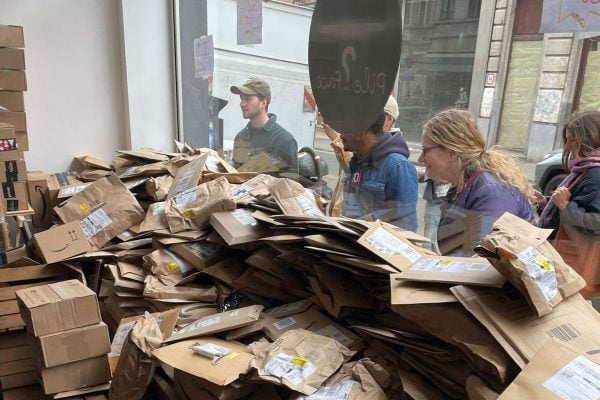 Melanie Blade, SellerEngine Ecommerce Content Creator. Melanie takes an active interest in all things Amazon. She keeps an eye on the latest developments and keeps Amazon sellers up to speed. Today she takes a look at Amazon returns for the 2021/2022 peak season with updates on what sellers should expect:
Melanie Blade, SellerEngine Ecommerce Content Creator. Melanie takes an active interest in all things Amazon. She keeps an eye on the latest developments and keeps Amazon sellers up to speed. Today she takes a look at Amazon returns for the 2021/2022 peak season with updates on what sellers should expect:
We’re only weeks away from Jan. 3, 2022, and already the dread of ‘Takeback Monday’ is looming over us. After all, Statista claims nearly half of people returned something in 2021. So, it’s likely that last year’s forecast of a 63% rise in returns will once again ring true.
Here’s what you should know and do…
How Amazon Holiday Returns Affect Your Performance
Not only are Amazon returns costly, but also potentially troublesome. It’s not only about justifying your restocking fees or dealing with serial returners. As they pile up, returns may trigger an account suspension, especially when the item’s authenticity is in doubt.
And then there’s overage. Q4 stock limits enforced on Oct. 1 will continue until the end of the year. But until then, the second stock review is due. So, FBA sellers should keep an eye on their IPI score, and make sure that it rises above the current IPI threshold of 500 by Dec. 27.
Amazon’s 2021 Extended Return Policy
Here’s some good news. This year’s extended return policy is stricter. The return window is still open until Jan. 31, 2022, but only for items bought between Nov. 1 and Dec. 31. Last year, buyers could return items they’d purchased as far back as October.
Amazon Extended Return Policy
•There are discrepancies across marketplaces. The US policy states that baby items have a 90-day return window, and Baby Registry gifts can be returned within a year of delivery.
•Amazon will cover shipping costs for defective and cancelled items, as well as return costs for items that are defective, damaged, incorrect, or cancelled.
•Amazon will also cover return costs for items in the Shoes, Clothing, Jewellery and Watches, and Handbags categories.
The policy change is all the more reason for sellers to update their storefronts on every marketplace, clarifying their return policies. Also, it’s worth reminding buyers that not all items are eligible for free returns.
In fact, some items can’t be returned at all. This applies mainly to products that deteriorate, expire, or mix. But it also applies to items that lose their hygienic seal (swimwear), drop in value if unsealed (software), or have volatile prices (alcoholic beverages).
Handling Amazon Holiday Returns: Budget, Rules, Research, Strategy
- Budget for Amazon Returns and Refunds
Returns are costly. Aside from regular Amazon fees, sellers cover the refund cost for the item, the shipping cost, referral fees proportional to the refund, and the refund commission. They also cover the Cost of Goods Sold, the loss in value, and removal costs for unsellable items.
Estimating refund costs can be tricky, because these costs eat into your profits. If your Q1 profits are stable year-on-year, you can use Q1 figures from 2021 as a benchmark. So, if last year’s refunds slashed only a third off profits because the resale value was high, a realistic budget for Q1 2022 returns might be about 35%-40% of Q1 2021 profits.
Budget for Amazon Returns and Refunds
Optimistic Approach Realistic Approach Pessimistic Approach Sales £20,000 -£1,000 (38%) £20,000 CoGS -£5,000 £20,000 -£5,100 Taxes -£3,000 -£5,050 -£3,000 Amz Fees -£8,500 -£3,000 -£8,600 Refund Costs -£1,000 (33% of Profit) -£8,550 0 Resale Price £500 £250 -£1,000 (43% of Profit) Profit £3,000 £2,650 £2,300 - Learn Amazon’s Return and Refund Rules
On Amazon, there are a few rules when it comes to returns and refunds. Some are universal. Others are specific to Amazon gift returns. Others apply to sellers only. For instance, charging restocking fees is allowed, but they are treated as ‘refund reductions’. So, they’re partial refunds.
Sellers can also issue refunds on top of what buyers paid. These are known as concessions, and are billed to their seller accounts. Also, sellers can offer free replacements. But as of Apr. 15, 2021, replacements must be sent out as soon as buyers return the original items.
Amazon Refund Rules
7 Amazon Refund Rules
•Return costs are deducted for voluntary returns.
•Shipping fees are not reimbursed for voluntary returns with requests made after 14 days.
•Returns are free for shoes, clothing, jewellery, and watches.
•The buyer’s return costs are reimbursed if the item is damaged, defective, or incorrect.
•Some items are eligible for instant refunds, with or without a return.
•Gift givers receive refunds, while gift recipients get gift cards.
•Gift recipients can’t ask for exchanges or instant refunds.7 Seller Refund Rules
•2-day deadline for return request authorisation.
•2-day deadline for issuing refunds after the item is received back.
•Not at fault if untracked items worth over £50/€50 are not received.
•Not at fault if uninsured items worth over £100/€100 are not received.
•No refund for gift wrapping.
•Refund cheapest shipping only.
•Deduct shipping for personalised pre-paid label.Amazon Free Replacement Rule
•Only for MFN and SFP items with sufficient units in stock and in the same condition.
•Buyers have 7 days to return an item from the moment they asked for a replacement.
•The first return scan must take place up to 10 days from the replacement request.
•Sellers can cancel the replacement, but it counts against them. If sellers enable the
•Returnless Refund option, Amazon offers the buyer the option to choose between a refund and a free replacement.
•When buyers choose a replacement, sellers are spared the cost of refund administration fees and they can also file SAFE-T claims.Amazon Restocking Fee Guidelines
•Refund up to 100% of the price of a video game or open software, if the buyer simply changed their mind.
•Up to 50% restocking fee if sent back within the return window, as long as it’s a:
•Book that has been used by the buyer.
•Media item that’s been taken out of its wrapper.
◦Non-media item that is damaged or different from what was sent.
◦Up to 20% of item price, if the buyer changed their mind and returned too late.
•Nothing, if the buyer returned the product on time, unused, and undamaged. - See Returns as an Opportunity
Sellers sometimes take returns too personally, when they should see them as a chance to grow. Returns can point to troublesome listings, high-risk items that aren’t a good fit for your business model, or a flaw in your return policy. Check the rules again and see if you can spot a pattern.
Ultimately, you want to convert returnees into return buyers. For that, you need a customer service team with a lenient approach. And if you find yourself in need of reinforcements in January, call on SellerEngine’s Account Monitoring team for help with metrics and compliance.
- Build Your Own Amazon Return Strategy
When it comes to returns, Amazon’s rules are the red-line. But you can pave your own path. You can decide what items you’re willing to take back and for how long, within those limits. But be sure your storefront displays your return policy. You could even refer to it in condition notes.
Finally, if you’re ever in trouble because of Amazon returns, our Account Rescue team can step in with a free assessment. If you want us to have a look at an appeal you’ve already submitted, our Business Coaching team is happy to assist. And we even have a team of Listing Reinstatement experts who will gladly lend a hand.
Having said all that, this year’s Amazon holiday returns could still take us all by surprise. That’s why we’d like to invite you to sign up to our bi-weekly Services newsletter. Information is power, and at SellerEngine, we’re happy to share it.










